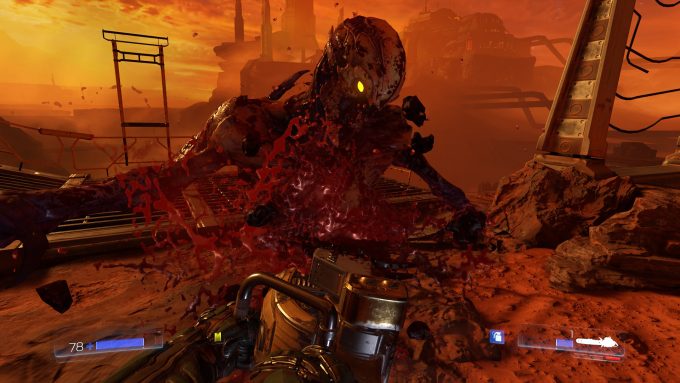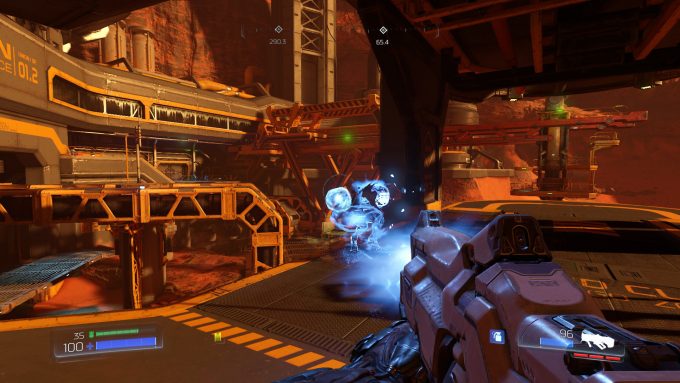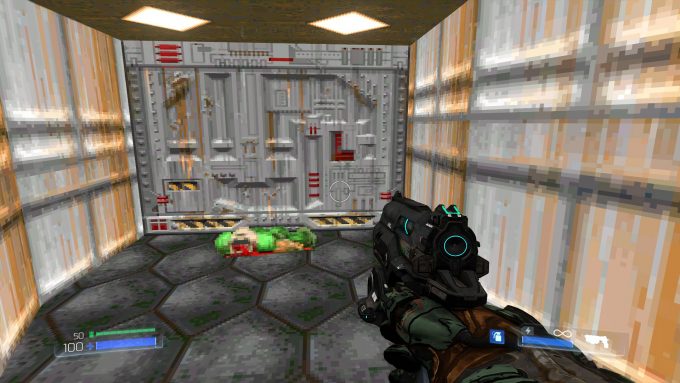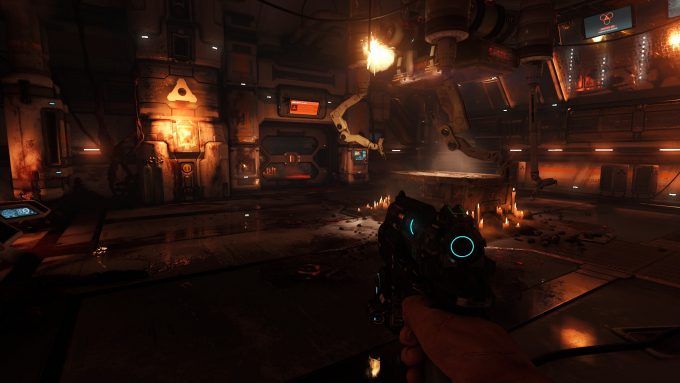- Qualcomm Launches Snapdragon 4 Gen 2 Mobile Platform
- AMD Launches Ryzen PRO 7000 Series Mobile & Desktop Platform
- Intel Launches Sleek Single-Slot Arc Pro A60 Workstation Graphics Card
- NVIDIA Announces Latest Ada Lovelace Additions: GeForce RTX 4060 Ti & RTX 4060
- Maxon Redshift With AMD Radeon GPU Rendering Support Now Available
An Oh-so-satisfying Demon Shooter: DOOM (2016) Review

DOOM set off a firestorm of debate back in 1995, and it came down to: you either liked it, or you didn’t. The game pushed the boundaries at the time, and it solidified itself as the standard of the FPS genre. Now, almost 20 years after that turbulent time, id has rebooted the franchise. Does it still hold sway over gamers in this day and age? Let’s cock that shotgun and find out.
The year is 1995. No wait, that isn’t right. The year is 2016! No wait, that isn’t right, either! Oh right, the year is 2096. The UAC is run by Dr. Samuel Hayden, madman or genius (that’s for you to decide), who has ushered mankind into a prosperous age of clean energy – from hell portals on the surface of Mars. These fissures into hell are too small to allow the army of darkness into our world, but Dr. Hayden has embarked on several scientific expeditions into hell, where he has managed to bring back several living specimens for study, including the DOOM Slayer sarcophagus.
A UAC scientist, Olivia Pierce, decides it isn’t enough for us to just study the minions of hell but rather we need to become them, no matter the cost. When the first stage of her plan is executed, almost 83% of the staff are altered to serve as hosts for the demon spawn. Dr. Hayden unleashes the DOOM Slayer from his slumber and aides him in stopping hell from being let loose on Earth.
From the moment your avatar awakes, it is obvious this is classic DOOM. There is no health regeneration. Armor and health packs are picked up, and ammo is scarce. Unfortunately, the game also limits your mouse movement and there is no in-game option to disable it. The best way I can describe this is: when I moved my mouse, it was like my player was moving in water or was in slow motion. This had to change, and the only way to do it was to set up a launcher argument to disable mouse smoothing. I really cannot fathom why this is forced on PC gamers; it’s an awful feature and should be fixable in-game along with other features some people want changed.
After that was handled, I embarked on my mission to kill every single minion of hell that dared to enter my path. This first level doesn’t offer much but a few secrets, and if you’re lucky to find it, the option to play a single classic DOOM level at the main menu will be revealed. Other classic levels are hidden in the levels you progress through. Future levels also provide additional challenges based on how you kill certain demons and the combat objects are tallied based on how many of hell’s minions you kill in the level.
The obvious question is: why should you bother? Well, in this game you can upgrade your armor and weapons, and these optional challenges and optional combat objectives give you extra upgrade points. The game can be completed in under 10 hours, on average, if you just run through it, so this is the only way to prolong your stay in each level to achieve the maximum benefits from them. It also makes things more interesting per level and when hunting for secrets, you can get creative on how you approach all of these additional objectives.
The biggest complaint I have with the single player campaign is that it is all checkpoint saves. There is no indication that there is more than one save file, so if something goes bad, you will lose all progress up to that point. The menu is also pretty confusing at first. For instance, you have to go into a save profile to change any of game’s settings. Why isn’t there a central menu to configure it for all profiles and why does it need to be done individually? These things feel like an afterthought and it is disconcerting given id’s pedigree with the PC.
When the single player experience ends, you might be tempted to hop into the multi-player game. Unfortunately, the only way to join a multi-player game is by going through the matchmaking service, which means you’ll be waiting for a game so long as there are others to play with. I tried on two separate days to play team deathmatch, but unfortunately, no one ever showed up in the matchmaking queue after waiting almost 10min. This is a clear reason why we need dedicated servers, so people can find players, even if they’re out-matched with the game’s level system. My poor experience in even being able to join a multi-player match doesn’t bode well for the game’s season pass – which is focused entirely on multi-player.
The graphics of the id Tech 6 engine is much more stable than its predecessor, though it still isn’t perfect. To experience the least amount of texture pop-ins, you will need to install this game on an SSD, and even then, it is still noticeable at times. There are also inconsistent levels of texture quality, for example; the hand of the space marine is sharp, well-defined and the colors are vibrant, but if you look at the leg or arm when you melee someone, it is blurry, the colors are washed out and shapes are not as distinct.
This happens often to consoles you need to interact with and many more secondary assets on screen. This broke the flow of quality enough that I noticed it frequently and it isn’t something that can be unseen when you get in the habit of looking at the high quality textures that the game starts you off with. It should be noted that this game is optimized well beyond that of other games in the genre. There are VRAM limitations in the settings, but what can be enabled in-game, runs very well.
Those with Multi-Monitor and Ultra-Wide systems will have additional obstacles when trying to play at their full resolution. The aspect and FOV are out of proportion so you must run Flawless Widescreen to fix these issues.
Audiophiles are not going to be disappointed in this game’s implementation of surround sound. At almost every turn the environmental audio was a perfect 5.1, not a reverse stereo on the rear speakers. I was certainly immersed in a way that does not happen very often.
The voice acting is what you would expect from a AAA game so there is nothing really special here. The music is another story: it is very dark and haunting. Evoking a sense of dread at almost every turn and level you explore. This, along with the graphics, are the things that help promote fear and anxiety, not closet monsters and jump scares that we saw in previous DOOM titles.
In the end, DOOM offers a solid single player experience, but the multi-player one is dreadful. I want to say that this should be a no-brainer to pick up, but the lack of configurable features, inconsistent texture quality, and again, the poor multi-player implementation, is what holds me back from recommending the game at the $60 price point. Now, if you’re someone who doesn’t care for multi-player, then the $60 price point is likely worth it to you. But if you want something more, it would be best to wait for it to come down to $50, or even $40. At those prices the issues are much more forgivable.
Pros
- Optimized graphics (and will soon support Vulkan).
- 5.1 audio is fully utilized.
- Finding classic maps & other secrets.
- Customize weapons & armor.
- Challenges & combat rewards.
Cons
- Limited MM & UW Support.
- Texture pop-ins are still a thing.
- Multi-player.
- Checkpoint saves.
- No in-game option to disable mouse smoothing.
Support our efforts! With ad revenue at an all-time low for written websites, we're relying more than ever on reader support to help us continue putting so much effort into this type of content. You can support us by becoming a Patron, or by using our Amazon shopping affiliate links listed through our articles. Thanks for your support!








